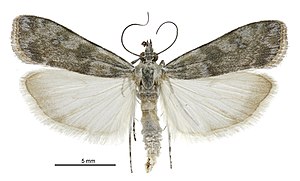Eudonia asaleuta
| Eudonia asaleuta | |
|---|---|

| |
| Female | |

| |
| Male | |
| Scientific classification | |
| Kingdom: | Animalia |
| Phylum: | Arthropoda |
| Class: | Insecta |
| Order: | Lepidoptera |
| Family: | Crambidae |
| Genus: | Eudonia |
| Species: | E. asaleuta
|
| Binomial name | |
| Eudonia asaleuta | |
| Synonyms | |
| |
Eudonia asaleuta is a moth of the family Crambidae.[1] It was described by Edward Meyrick in 1907.[2] It is endemic to New Zealand and has been collected in the South Island in the West Coast, Fiordland,Canterbury, Otago and Southland regions. This species inhabits bare shingle areas as well as tussock habitat with few trees or scrub at altitudes of under 1000 m. Adults are on the wing from November to February.
Taxonomy
This species was first described by Edward Meyrick in 1907 using specimens collected at Lake Wakatipu by George Hudson and named Scoparia asaleuta.[2][3] George Hudson discussed and illustrated this species in his book The butterflies and moths of New Zealand.[4] In the 2010 the book The New Zealand Inventory of Biodiversity placed this species in the genus Eudonia.[1] However some publications, subsequent to that book, continue to refer to this species as Scoparia asaleuta.[5]
Description
Meyrick described this species as follows:
♀. 21-23 mm. Head, palpi, and thorax prismatic bronzy- grey, suffusedly irrorated with white ; palpi 2+1⁄4. Antennae dark grey, suffusedly ringed with white. Abdomen pale ochreous, sprinkled with grey. Forewings very elongate, narrow, posteriorly dilated, costa subsinuate in middle, slightly arched posteriorly, apex obtuse, termen nearly straight, hardly oblique, rounded beneath ; iridescent pale ochreous mixed with dark bluish-grey, wholly suffused or densely irrorated with white except dark markings as under — viz., an undefined subbasal fascia ; a nearly direct fascia representing first line, dilated posteriorly above middle ; an 8-shaped discal mark ; a broadt erminal fascia, on which the second and subterminal lines appear as whitish shades confluent in middle and sometimes partially obsolete : cilla whitish-ochreous, tips whitish, with narrow basal and broader postmedian grey shades. Hindwings without hairs in cell ; pale greyish-ochreous, with suffused dark-grey terminal fascia ; cilia ochreous-grey-whitish, with grey basal line.[2]
This species has forewings that a coloured a bluish grey with a sheen that camouflages the moth against rocks.[5]
Distribution
This species is endemic to New Zealand.[1] It has been found in the West Coast, Fiordland, Canterbury, Otago and Southland.[6][2][4] In particular it has been collected in Lake Wakatipu, Aoraki / Mount Cook, Waiho River bed, Lake Manapouri, Hope Arm in Fiordland, Danseys Pass, Makarora and Invercargill.[2][6][7]
Habitat
This species is known to inhabit open areas of bare shingle as well as tussock habitat with few trees or scrub at altitudes of under 1000 m.[8][6][9]
Behaviour
The adults of this species are on the wing from November to February but are more common in January and February.[6][8] This species has been collected in light traps, Malaise traps, and pan traps.[10]
References
- ^ a b c d No label or title -- debug: Q45922947, p. 458, Wikidata Q45922947
- ^ a b c d e No label or title -- debug: Q110404133, p. 111, Wikidata Q110404133
- ^ No label or title -- debug: Q45083134, p. 160, Wikidata Q45083134
- ^ a b No label or title -- debug: Q58593286, Wikidata Q58593286
- ^ a b No label or title -- debug: Q94481265, p. 54, Wikidata Q94481265
- ^ a b c d No label or title -- debug: Q66085040, Wikidata Q66085040
- ^ No label or title -- debug: Q109420935, p. 424, Wikidata Q109420935
- ^ a b No label or title -- debug: Q54755440, Wikidata Q54755440
- ^ Department of Conservation (January 2006). Crown Pastoral Land Tenure Review - Coronet Peak part 1 (PDF) (Report). Land Information New Zealand. Retrieved 24 January 2018.
- ^ Murray, Tara J. (15 September 2019). "Invertebrates of the Tasman River Plain: Characteristics of the invertebrate community and an analysis of sampling methods for biodiversity assessment" (PDF). Department of Conservation. Retrieved 1 August 2022.
Error: "Q15640010" is not a valid Wikidata entity ID.
- Articles with short description
- Articles with 'species' microformats
- Commons link is the pagename
- Taxonbars desynced from Wikidata
- Taxonbar pages requiring a Wikidata item
- Taxonbars with invalid from parameters
- Taxonbars without secondary Wikidata taxon IDs
- Moths described in 1907
- Moths of New Zealand
- Eudonia
- Endemic fauna of New Zealand
- Taxa named by Edward Meyrick
- Endemic moths of New Zealand
- All stub articles
- Scopariinae stubs

